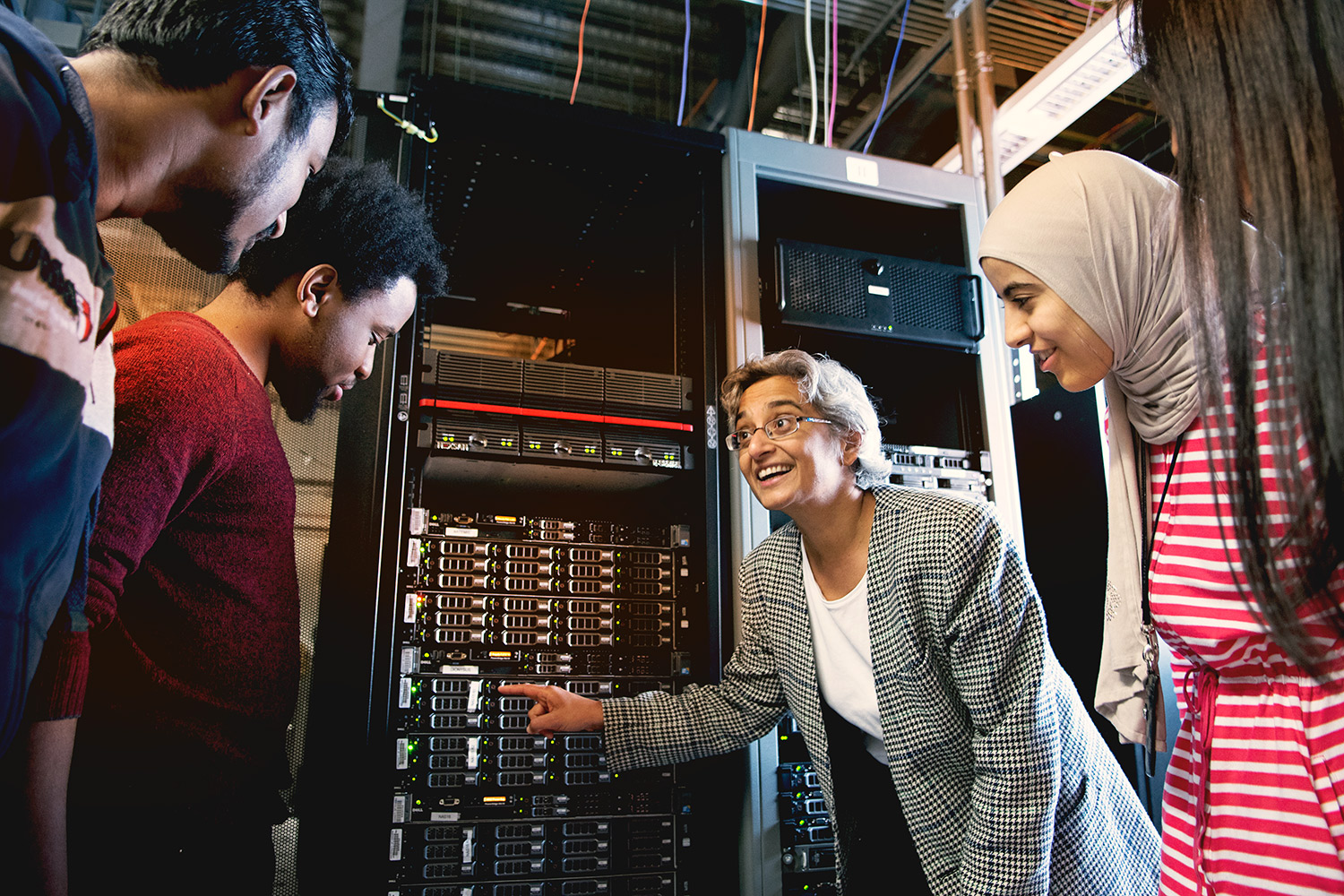The latest supercomputers and large-scale observatories like the Large Hadron Collider have the power to support unprecedented breakthroughs in astrophysics, genomics, climate science and scores of other fields.
They can fulfill their potential, however, only if the networks that connect them to scientists and researchers around the world are equally robust, able to move enormous quantities of data precisely, reliably and at extremely high speeds.
Malathi Veeraraghavan, a University of Virginia professor of electrical and computer engineering, is creating applications and protocols to ensure that communication to and from these state-of-the-art instruments is as efficient as possible.
Because she is working with the latest, most advanced networking hardware available, Veeraraghavan is always breaking new ground. Furthermore, any solutions she develops must observe the exacting network standards required for scientific research and reflect the unique characteristics of the data being transmitted.
Although the intellectual challenges are substantial, Veeraraghavan is also drawn by the desire to help the scientific community drive discovery. “The projects I choose are designed for impact,” she said, an approach that reflects her 10 years in industry before she joined the School of Engineering and Applied Science faculty. “I want to solve problems that make a difference.”
Providing More Efficient Distribution of Weather and Climate Data
For instance, Veeraraghavan has been collaborating with scientists at the nonprofit consortium University Corporation for Atmospheric Research, which, as part of its Unidata Program, collects and distributes a continuous stream of near real-time weather and climate data to subscribers at 260 institutions around the world. This is a substantial quantity of data. Satellites and observatories on land generate more than 80 terabytes of data weekly – and this amount is only increasing.
Currently, UCAR uses a unicast system, essentially relaying the data from point to point in the network. “As the volume of data and number of receivers grow, this structure requires an increasing number of computing resources and increasing network capacity,” Veeraraghavan said.
Her High-Speed Networks research group has developed a reliable multicast transport protocol for use over Software-Defined Networks that sidesteps the limitations of the traditional multicast Internet protocol and that better accommodates the continuous flow of data.
Veeraraghavan’s group has worked closely with UCAR collaborators to integrate their new protocol into the newest version of the UCAR data distribution software and is working to beta-test it and then roll it out.
Tapping Cloud Computing to Make Robots More Intelligent
Another project that illustrates Veeraraghavan’s desire to have an impact is her collaboration with Southwest Research Institute and the University of Texas at Dallas to use high-performance cloud-based computing to enhance the capabilities of industrial robots.
“Robots excel at high-volume, repetitive tasks, but if they are to act more autonomously in complex, dynamic environments, they need sophisticated, real-time computer vision,” she explained.
The problem is that this degree of computer vision – the use of sensors and algorithms to identify objects – requires heavy compute cycles. Veeraraghavan, with her High-Speed Networks research group, and colleagues at Southwest Research Institute and the University of Texas at Dallas, are developing protocols to transmit sensor data from robots to a cloud-based parallel computing platform, where the sensor data would be continuously analyzed and instructions to the robots would be generated.
Creating More Flexible Fiber Optic Networks to Accommodate More Data
A third example of Veeraraghavan’s determination to make a difference is her work on optimizing high-speed fiber optic networks. To address issues like security and reliability and to have capacity to accommodate peak volumes, these networks are overprovisioned and underutilized. In some cases, only 30 to 40 percent of the network is actually being used to transmit information. With Internet traffic doubling in volume every two years, network providers must either commit to laying ever-more fiber optic cable or find ways to make more efficient use of existing capacity.
With support from the National Science Foundation and Japan’s National Institute of Information and Communications Technology, Veeraraghavan and colleagues at Keio University, the oldest private university in Japan, are investigating changes to network architectures that would allow the links between Internet protocol routers to adjust to the capacity of the data running between them. “Imagine a highway in which the lanes change size with the nature of the traffic,” Veeraraghavan says. “When motor scooters are on the road, you could narrow its lane. When there are wide loads, you can make the lanes bigger. The net effect is that you make better use of the capacity you have.”
Here again, Veeraraghavan hopes to have a measurable impact on high-performance networks, but these projects also have an impact on her.
“In the course of working on projects that involve weather information or robots – or working with collaborators from Japan – I learn a great deal about fields far from electrical and computer engineering,” she said.
Media Contact
School of Engineering and Applied Science
emather@virginia.edu (434) 924-1381
Article Information
June 20, 2016
/content/professors-work-focuses-revving-our-highest-speed-networks

